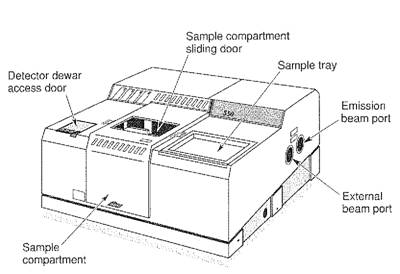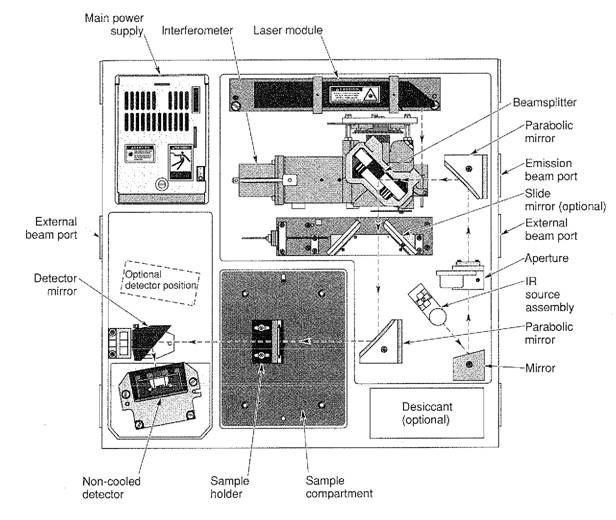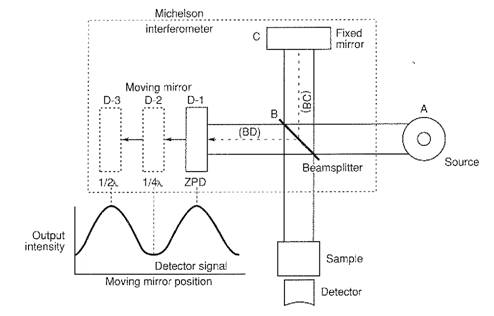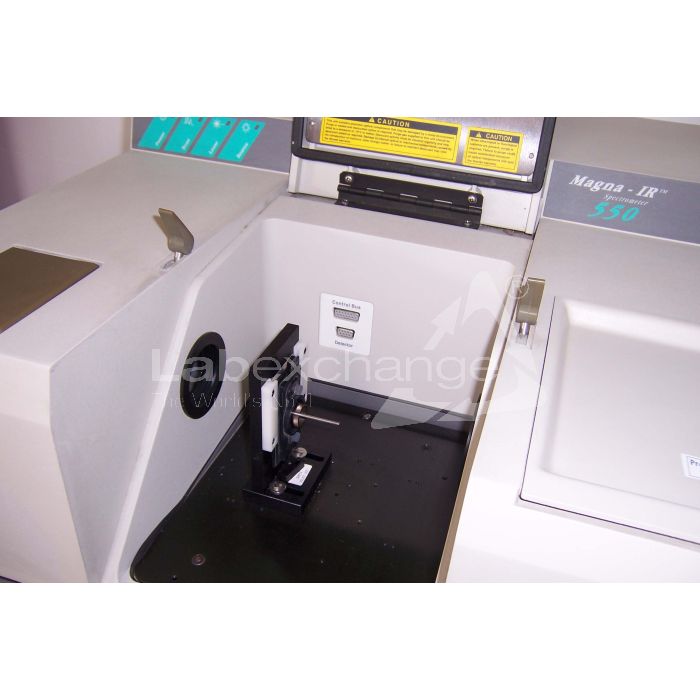Nicolet Magna IR 550
| Objektnummer | B00017277 |
|---|---|
| Seriennummer | 017277 |
| Nome oggetto | Nicolet Magna IR 550 |
| Stato | Archived Product |
Gruppo prodotti: Spettrometri Infrarosso
Status, terms of delivery and payment
Verification of devices
The second-hand devices are verified by Labexchange Service GmbH before delivery. You are receiving only fully functional devices.
Dispatch time
The stated dispatch times are the shortest possible ones for each article. The effective dispatch times can vary. The effective dispatch times will be stated in the order confirmation.
As a matter of principle, we are offering collective deliveries. The shipping time is calculated based on the position with the longest lead time. A partial delivery is possible on explicit request.
Shipping methods
Parcel services, forwarding agencies, self-pickup, delivery by Labexchange fleet.
Delivery information
Prices exclude shipping costs. Stated shipping costs are to be expected. Deviations are possible. If transport costs are not specified, please ask separately for them.
The stated transport and packing charges apply to the most favorable route if transport and are to be understood as subject to verification due to unexpected cost increases. By reason of unpredictable events, cargo rates and delivery times can change at any time and therefore have to be adapted to the recent situation. Import formalities and possible customs charges will be borne by the purchaser. Incoterm coding according to Incoterms 2010: For persons who collect the devices themselves: EXW, for dipatch by sea: CFR, by air freight: CPT, other shipments: DAP. Note for international shipments: A proof of preference/EUR1 will not be issued by us. When self-collecting/ordering EXW from countries within or outside the European Union, 16% VAT will be retained as a deposit until we have received the corresponding confirmation of arrival/bill of delivery from the buyer.
Terms of payment
We do not accept payment by letter of credit, PayPal, etc. In each case the invoice amount is payable without deduction. Discount is not granted.
|
Country |
Possible payment methods |
Comment |
|
DE, AT, CH |
Payment by invoice, payment in advance, payment by credit card |
Payment by invoice is only possible for corporate clients. |
|
NL, BE, LU |
Payment by invoice, payment in advance, payment by credit card |
Payment by invoice is only possible for corporate clients |
|
Other countries |
Payment in advance, payment by credit card |
|
Our General Terms of Sale, Delivery and Payment are valid and are available for download here.
The goods are offered subject to prior sale.
Definition of status
All articles are used articles, except an article is listed especially as a new device.
|
Status |
Condition |
Comment |
|
Immediately available |
Used | The article is fully functional and in impeccable condition. It can be shipped immediately. |
| In stock |
Used |
The article is on stock. Our service technicians will verify the article before delivery. You are receiving only a fully functional article. |
|
Published |
Used |
The article is still with the provider. After your order the article will be purchased and verified by us before being shipped to you. A certificate of operativeness as well as a service report are included in delivery. |
|
New device |
new |
The article is brand new and unused. Regarding new equipment the guarantee/warranty conditions of the corresponding manufacturer apply. |
|
Labprocure |
Used |
Labprocure GmbH, as the advertiser, is responsible for the content of this device offer. Labprocure assumes liability for the offers advertised here and for the photos and offer texts included. Labprocure GmbH, Bruckstraße 58, 72393 Burladingen. |
manufacturer : Nicolet
model : Magna IR 550
annotation : Dokumente engl.
The following illustrations and descriptions refer to the instrument model and are drawn from brochures. They do not represent the scope of delivery. Please refer to the text of the offer for the exact scope of delivery.

Nicolet's Magna-IR System 550 is a complete spectrometer capable of up to 0.125 cm-1 resolution. The interferometer Features Auto-Tune system alignment and continuous dynamic alignment. Using precise Digital Signal Processing (DSP), the interferometer provides exact scan reproclucibility and collection of miaute signals.
The System 550 is designed Wand-, near-, and far-infrared spectral range coverage. Spectra may be collected and sequentially stored at raten of up to 20 scans per second using the Rapid Scan option.
All optical bench functions are fully automated and controlled via Nicolet's OMNICTM software. Diagnostic status of all system components is reported to the FT-IR workstation. Multiple scanning velocities, a variable-diameter aperture, and multiple beam paths enable a wide array of experimental conditions.
The system has beeis designed so that you can install it yourself. You can also replace key parts of the optical bench, such as-thelaser and infrared source.
Optical Bench Description
The major components of the System 550 optical bench are identified and briefly described in düs chapter. Components are listed according to their order in the path of the infrared (IR) beam.

Source The IR beam of radiation is produced by the source. The System 550 is equipped with an Ever-GloTM mid-IR to far-IR source or a tungsten-halogen, near-IR source.
Aperture The aperture is a variable-diameter opening that can be adjusted to
control the arnount of IR radiation that reaches the sample.
The aperture can also be adjusted to achieve maximum spectral resolution.
Interferometer From the source the beam is reflected from mirrors into the interferometer, which splits the beam, modulates the intensity of all frequencies of IR light, and then recombines the beams. The interferometer features Auto-Tune system alignment and continuous dynamic alignment.
Beamsplitter This device inside the interferometer separates the beam into two beams of nearly equal energy. One of the beams is reflected from the beamsplitter to a fixed mirror and then back to the beamsplitter; the other beam is transmitted through the beamsplitter to a moving mirror and back to the beainsplitter, where the beams recombine.
Moving mirror While reflecting the IR beam back toward the beamsplitter, this mirror moves toward and away from the beamsplitter in a repeating cycle. This motion enables the computer to subsequently convert the beam to an IR spectrum.
Laser The laser is used as an internal calibrator in FT-IR instruments because it emits light at a known and constant frequency. All spectra are coliected at precise laser-calibrated points which generate wavenumber accuracy better than ±0.01 cm -1 . The laser helps control the moving mirror's position and signals the capture of data.
Sample compartment Samples are placed fiere for analysis. A focused IR beam. passes through (or reflects from) the sample and goes an to the detector.
Detector After beeng absorbed at specific frequencies by the sample, the
remainder of the beam is focused onto the detector, which produces an electrical signal in response to the energy striking it. The signal is sent to a computer for processing. The System 550 Features interchangeable detectors and has a dual detector option.
Sampling accessories Most accessories fit into the sample compartinent, but some require separate housing and optics. Nicolet offers auxiliary experiment modales, rnicroscopes and gas chromatography interfaces with the System 550.
Accessories that have their own optics require an external beam option. Mirrors are repositioned by computer commands to direct the IR beam through a port on the right or left si.de of the bench. The beam then travels into the accessory's optics.
Also available is an emission betan option, which allows collimated radiation from an external IR source to be directed through a port in the right side of the main bench and into the System 550 optics.
Note If you would like more information on how FT-IR spectrometers work, real the next section, "Fundamentals of IR Analysis."
Fundamentals of IR analysis
Infrared (IR) spectrometers measure the interaction of IR radiation with experimental samples. Spectormeters measure the frequencies at which the sample absorbs the radiation, and the intensities of the absorptions.
Determining these .frequencies al lows identification of the sample's chemical makeup, since chemical functional groups are known to absorb light at specific frequencies. Identification of what makes up the sample is called qualitative analysis, one of two major applications of IR spectrometry.
The other application. is quantitative analysis. The intensity of an absorption is related to the concentration of th.e component. After the spectrometer is calibrated, which establishes how concentration changes affect absorbance changes, the absorbance for an unknown sample can be used to calculate concentration.
Intensity and frequency of sample absorption are depicted in a twodimensional plot called a spectrum. Intensity is generally reported in terms of absorbance, the amount of light absorbed by a sample, or percent transmittance, the amount of light which passec through it. Frequency is usually reported in terrns of wavenumbers.
What makes up an unknown sample, and how rauch of each component is present in that sample, can be invaluable infortnation. Its many applications incl.ude research and development of new products, quality control of manufactured goods, forensic analysis and environmental testing.
FT-IR Spectrometers and how they work
IR light from the source ("A" in the Sketch below) is directed into the Michelson interferometer, the key component to FT-IR spectrometry. The interferometer modulates each wavelength of IR light at a different frequency.
In the interferometer the light beam strikes the beamsplitter (B), as shown below. About half of the light is reflected from the beamsplitter and is directed anto the fixed mirror (C). The remainder of light is transmitted through the beamsplitter and is directed onto the moving mirror (D). When the beams recombine, constructive or destructive interference occurs depending an the position of the moving mirror relative to the fixed mirror.

When both mirrors are the same distance from the beamspliner, the two reflected beams pass through exactly the same pathlength and, consequently, are totally in phase (distance BC = BD). The resulting signal intensity is at its maximum, a point called the Zero Path Difference (ZPD).
The modulated beam is reflected from mirrors to the sample, where selective absorption takes place.
From the sample the beam travels an to the detector, which translates the beam into an electrical signal.
The cosine waves produced by the source and modulated by the interferometer appear to the detector as ar7 interferogram, a signature of intensity versus mirror position. The interferogram is a summation of all the IR light frequencies; for all practical purposes it cannot be interpreted in its original form.
The signal from the detector is sent to a computer and converted into an IR spectrum through a mathematical formula called Fourier Transform (FT). The formula calculates- the ampl.itude of each of the component signals. The amplitude gives the intensity at the corresponding wavelength of light.
Zero path difference
Laser Specifications:
The source of laser energy in the System 550 optical bench is a nominal 1 milliwatt (maximum 1.2 milliwatt), continuous 632.8 nm laser head. In some jurisdicitons you may be required to register the optical bench, check with your companys safety officer or your local government offices. The following is an excerpt from the laser manufacturers manual regarding the information that might be needed for registration.
Manufacturer Melles Griot
Type of Laser Helium Neon (Hehe)
Wavelength 632.8 nm
Minimum Power 0.7 mW (TEM 00 )
Nominal Power 1.0 mW
Maximum Power 1.2 mW
Beam Diameter 0.65 cm (1/e 2 )
Beam Divergente 2.0 mrad
Spacing Cl2L 1039 MHz
Operating Voltage 12 VDC
CDRH Classification IIIa





